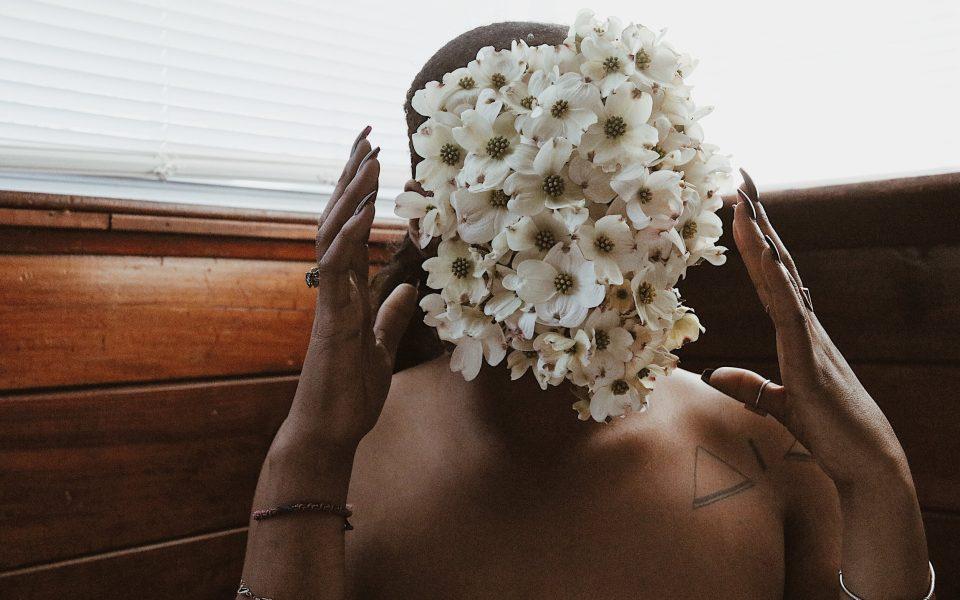
©
“When my mama finished my hair she would pull the hair from the comb, sit it in her ashtray and burn it,” Anj writes in the first line of a tender poem nestled on her website beside a photograph of people with intertwined arms, their faces obscured — his wound up with gauzy cloth and hers by an encirclement of braided hair.
“Anj” is multimedia artist, writer and creative entrepreneur Ashley Johnson, a UNCG grad who grew up in Winston-Salem and who’s recently landed her first solo exhibit in the Central Gallery at Greensboro’s Revolution Mill. Reach, a selection of Johnson’s past and contemporary works that focuses on generational aspects of Southern femininity and black-hair identity, will find a home at the old textile mill through Aug. 12.
“The crux of my work and the crux of who I am today is tied to the practices of black hair,” she says.
Johnson’s mother chemically straightened her hair for as long as she can remember. She recalls picking at scabs from burns the relaxer’s hydroxides seared into her scalp, and years of back-of-the-mind curiosity about the natural layer of growth underneath.
“This work started when I cut off all my hair,” Johnson says. “I had lived 24 years of my life without knowing what my actual hair looked like and I didn’t know anything about it. It was a foreign object. I didn’t know about porosity. I didn’t know there was such a thing as curl patterns; I hated it and I actually called myself ugly. I thought, I wanna know why I feel this way. And I also wanna know how far this feeling traveled to get to me because it’s not my own self-hatred. I started asking myself, ‘What did my mom say about my hair when I was growing up? What kinds of words did she use to describe my natural hair?’ It was never good, so I’m thinking, Where did my mom get that?”
That temporary state of fragile self-worth didn’t impede Johnson’s exploration of the subject. She’s nothing if not imaginative and steadfast.
“My whole process is very resourceful,” Johnson says. “We weren’t rich, so I’ve always been like, ‘If I don’t have this, then I will make this,’ never, ‘Well I don’t have a camera so I’m not a photographer.’ That makes no sense to me.”
Because she couldn’t afford anything close to a first-rate camera or lighting equipment, Johnson made a study of natural light; she knows the angle of the sun every hour of the day, regardless of season. She shot most of her first series Woven behind a Food Lion on her iPhone until running across a “janky” Cannon T-3.



As she turned away from photographing weddings and newborns she refocused her lens on dark-skinned women, faces decorated with delicate magnolias that had been blooming nearby or draped elegantly in large-scale woven pieces against blacker-than-black backgrounds. “Gleti,” moon goddess and ruler of the stars, wears a magnificent coral reef of magnolias and white-ish yarn structures. The later Magnolias series sought to tie together themes of Johnson’s hair journey in a larger body of work. Told in five chapters, Johnson captured dark women draped in white with masks of long braids encircling their heads, young ones shrouded in darkness and magnolia leaves.
“Those braided masks are me,” Johnson says. “All of my portraits are self-portraits. It doesn’t matter if it’s of a white girl with beads; they’re all distorted self-portraits.”
Her new work, though, is less planned and stylized.

©
“I have three nieces and they’re inspirational,” Johnson says. “I see so much of myself in them and I like documenting them so a lot of the new work I’m making is an observational look into their lives. I think just starting to document them was a push to create more because that felt natural [and] it has a different feeling.”
Her latest work stems from a sensitivity to tension and the questions that follow. This time, Johnson tackles cultural appropriation in a photo series also dubbed Reach.
“When you wear other people’s cultures sometimes it’s well intentioned,” she says. “Sometimes you have no intention; you like this print or braid style. But there’s such a visceral emotional reaction for black women when we see it. I wanted to trace that emotion and ask, ‘Why? What ownership do I have over cornrows?’ For African-Americans who don’t have a lot of lineage because of slavery or displacement, is being black enough?”

©
Reach hinges on striking images of a white woman wearing beaded Fulani braids. In one, the woman nonchalantly blows bubblegum, entirely unconcerned with the implications of her adornment.
“I haven’t worn those, I’m not from the Fulani tribe. Or am I?” Johnson questions. “I do know that I’m African-American, though, and I do know I’m a Southern woman.”
“I hope my work prompts others to ask questions about their ownership, about what they lift from other cultures,” Johnson continues. “I think that’s where some of the emotion comes from: feeling not credited, feeling that you’re good enough to be taken from but not good enough to be a representative of those things.”
Learn more at hiaj.co and visit the exhibition at 1150 Revolution Mill Drive (GSO).
Join the First Amendment Society, a membership that goes directly to funding TCB‘s newsroom.
We believe that reporting can save the world.
The TCB First Amendment Society recognizes the vital role of a free, unfettered press with a bundling of local experiences designed to build community, and unique engagements with our newsroom that will help you understand, and shape, local journalism’s critical role in uplifting the people in our cities.
All revenue goes directly into the newsroom as reporters’ salaries and freelance commissions.


Leave a Reply